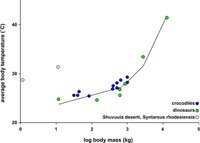Bigger..hotter.
I am not rambling about my sexual preferences; I am referring to an obsession of the masses whose only scientific exposure is to read some kind of digested scientific stuff in bad blogs run by depressed grad students like this one or in fancy magazines which make technical complications that took the best part of a few post docs look as simple as opening a can of coke.


The obsession I am talking about is dinosaurs; I am not talking about the sex life of dinosaurs either. (I have to pay the price of having a fancy title and get the point in such a round about way).
The topic is about temperature regulation in dinosaurs. Dinosaurs are large animals reaching up to 42 feet in height and 90 tonnes in weight. They were arguably the most successful tetrapods ever to have lived on this planet. But not a lot is known about their physiology, obviously. (Sigma doesn’t sell knock-out dinosaurs. I wish they did). How did they maintain their body temperature (homeothermy) is a big issue in biology for a long time.
The initial controversy was whether to slot dinosaurs into warm blooded (like birds and mammals) or cold blooded (reptiles, amphibians and fishes). Warm blooded animals, also known as endotherms maintain high body temperature supplied by large amount of internal metabolic heat and keep a constant body temperature in different thermal environments. They also have elevated rates of lung ventilation, oxygen consumption which allows them to thrive in many environmental niches unlike the cold blooded animals also called ectotherms.
The problem with slotting dinosaurs under endothermic animals is that endothermy or warm blooded animals evolved later and are found in birds and mammals. Slotting the dinosaurs under ectoderms is that they were thought to have lower metabolic rate and would depend on the sun to increase their body temperature which would make them sluggish.
But ‘Inertial homeothermy hypothesis’ carves a new category. This shows how being cold blooded doesn’t mean that they can’t maintain constant high body temperature (homeothermy). Many large reptiles bask in the sun and are able to maintain high temperatures all year long because of minimal surface-to-volume ratio and minimal heat loss. The commodore dragons, Galapagos tortoises and alligators are examples of large reptiles who maintain homeothermy in this way. Thus it was possible for the large dinosaurs to have large homes, pursue, hunt large prey and defend themselves fiercely.
A recent modeling study has shown direct evidence that dinosaurs maintained high body temperature by the ‘inertial homeothermy hypothesis’ which predicts the body temperatures to increase with body size. Their model based on growth curves of dinosaurs show that the body temperature of dinosaurs increased from 25.8 C at 12 Kg to 41.8 C at 13000 kg. To validate the model it was used to predict body temperature of crocodiles with different body masses which when tested empirically and was shown to be an accurate.
The initial controversy was whether to slot dinosaurs into warm blooded (like birds and mammals) or cold blooded (reptiles, amphibians and fishes). Warm blooded animals, also known as endotherms maintain high body temperature supplied by large amount of internal metabolic heat and keep a constant body temperature in different thermal environments. They also have elevated rates of lung ventilation, oxygen consumption which allows them to thrive in many environmental niches unlike the cold blooded animals also called ectotherms.
The problem with slotting dinosaurs under endothermic animals is that endothermy or warm blooded animals evolved later and are found in birds and mammals. Slotting the dinosaurs under ectoderms is that they were thought to have lower metabolic rate and would depend on the sun to increase their body temperature which would make them sluggish.
But ‘Inertial homeothermy hypothesis’ carves a new category. This shows how being cold blooded doesn’t mean that they can’t maintain constant high body temperature (homeothermy). Many large reptiles bask in the sun and are able to maintain high temperatures all year long because of minimal surface-to-volume ratio and minimal heat loss. The commodore dragons, Galapagos tortoises and alligators are examples of large reptiles who maintain homeothermy in this way. Thus it was possible for the large dinosaurs to have large homes, pursue, hunt large prey and defend themselves fiercely.

A recent modeling study has shown direct evidence that dinosaurs maintained high body temperature by the ‘inertial homeothermy hypothesis’ which predicts the body temperatures to increase with body size. Their model based on growth curves of dinosaurs show that the body temperature of dinosaurs increased from 25.8 C at 12 Kg to 41.8 C at 13000 kg. To validate the model it was used to predict body temperature of crocodiles with different body masses which when tested empirically and was shown to be an accurate.

1 Comments:
Thanks you just helped me out a lot with some inertial homeotherm. questions...
Post a Comment
<< Home